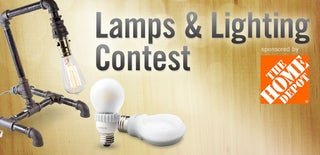Introduction: Touch Lamp
The basic idea for this is instructable is to make a lamp out of simple hardware and recycled materials that can be controlled by touching the metal base. I've been sitting on this idea for a while now, but seeing the Lamps and Lighting contest gave me the final push to actually make this idea a reality. Another great feature was that the entire lamp, minus the microprocessor, was made from items at Home Depot.
Lucky for me, I recently joined the Alamance Makers Guild. There, I met Danny, a computer whiz with a knack for Arduino. With his programming and circuitry skills and my ability to operate power tools, we were able to finish this project and hopefully get our Makers group known. We're also hoping to win some tools for the Maker Space we plan to build.
A special thanks to Roshenac, for her ible: Touch Sensitive Audio Desk Trays- Arduino https://www.instructables.com/id/Desk-trays/
We used the Arduino code from the trays as the start for our own code.
Step 1: Lamp Segments
The simplest way I could think to do this instructable was by segments of the lamp. Each segment is unique and independent. You can use an entirely different light enclosure, lamp base, or micro-controller, but the concept stays the same. This is a touch lamp made from simple hardware and micro-controllers.
Each section lists the materials and hardware used to make the part and the detailed instructions are put as notes in the accompanying pictures.
Total cost: $71.00 (if you aren't recycling or have an extra Arduino lying around)
Step 2: Arduino and Circuit
The code for the board is provided as a .txt. I would post it in this section, but I had trouble with the formatting.
The capacitive sensing library can be found here: Arduino Playground
Attachments
Step 3: Light Enclosure
Materials:
- 5" pine bun foot - 9.98 (in the aisle with decorative wood trim at Home Depot)
- Round globe (4" radius) - 7.98
- (3x) 10-32 set screw 3/8"
- (3x) 10-32 set screw 3/4"
- 3" length 1/8-IP thread - $3.57
- Porcelain fixture socket for ceiling fan - $2.98
Hardware:
- CNC milling machine for the pockets to attach globe and pole
- Vice to turn pre-installed screw out of pine bun foot
- 60º indexer to drill evenly spaced holes for set screws (could be eyeballed)
- 5/6" hex wrench to tighten set screws
The top assembly is focused on the pine bun foot. By modifying this part, we can mount the bulb and glass globe to the fence post.
To see a step-by-step breakdown for making the adapter, click through the above images.
Step 4: Lamp Base
Materials:
- 2"x4" x120" lumber - $4.34
- Cut into eight 8" pieces
- and eight 6" pieces
- 2" hinge - $2.47
- 10D 3" nails (You may want to get a smaller diameter) - $3.87
- (4x) 10-32 BHCS (button head cap screw) 2"
- 1-5/8" x 5'6" line post - $10.83
Hardware:
- Hand drill with 1/8" drill bit for pre-drilling nail holes
- Long phillips head screwdriver for mounting the hinge
- Hammer for nails
- Wood stain of choice (Minwax special walnut 224)
- Tie down strap (or clamps) for holding pieces together while nailing
To see a step-by-step breakdown for making the base, click through the above images.
A special thanks to Mr. Gene who either machined or instructed me to machine almost the entirety of this base.
Step 5: Final Assembly
Navigate the bulb wires down the pole and connect to the breadboard. Then, connect the alligator clip to the base of the pole. Finally, slide the electronics board into the base and close your secret door.
You can have your power cord stick out the secret door or through the hole in the base.
Step 6: 3D Files
For those who are interested, I created a 3D model of the lamp in Solidworks to make modifying the design easier. Let me know if you need the file saved in a format other than .SLDASM or .STL.
Step 7: Possible Improvements
One improvement that eventually became a necessity was a 12V LED light bulb. Surprisingly, we couldn't find one to buy, so Danny came up with a new light bulb, a "sensible light bulb".
We also started the project with the hope of controlling the dimming effect with sliding hand motions. Unfortunately, we were not able to make a circuit which allowed us to watch small changes in capacitance between sensors on each end of the pole. If anyone knows a good way to do this, we'd love to hear from you.

Participated in the
Epilog Challenge VI

Participated in the
Lamps and Lighting

Participated in the
Sensors Contest














